Japan
Wood Products Prices
Dollar Exchange Rates of 10th
November
2018
Japan Yen 113.81
Reports From Japan
¡¡
Natural disasters disrupt
production and drive down
machinery sales
Data on machinery orders derived from a survey
conducted by the Cabinet Office in Japan show that in
September orders fell by the most ever recorded.
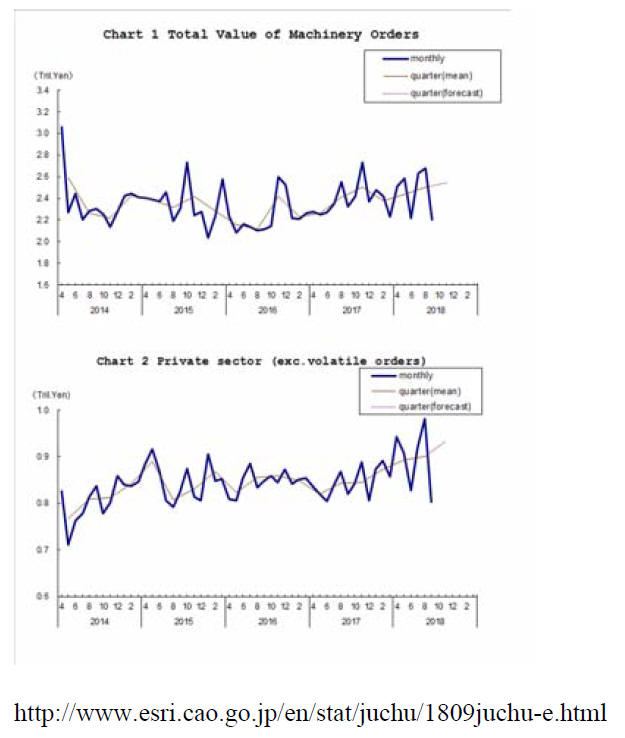
The cause of this has been put down to the series of
natural disasters. Western Japan experienced widespread
flooding in early September due to one of the most
powerful typhoons ever to pass over the country. The
international airport in Osaka was damaged and had to
close.
The typhoon was followed almost immediately by a
magnitude 7 earthquake in Hokkaido causing widespread
blackouts and then another typhoon hit western Japan at
the end of September.
These events disrupted business activity so it is not
surprising that there was an 18% dip in machinery orders.
Manufacturers surveyed by the government expect
machinery orders to come in higher in the last quarter of
this year but uncertainties on the direction of global trade
have analysts worried.
Japan's gross domestic product fell a seasonally adjusted
0.3% in the third quarter of 2018 in line with expectations
following the 0.7% gain in the previous three months. On
an annualised basis, GDP declined 1.2% year on year.
Infrastructure spending to be boosted to support
growth
The Japanese media over the past weeks has focused on a
growing concern among policymakers about the direction
of the economy which contracted in the third quarter. The
recent drop in machinery orders has also worried
policymakers.
In the face of these risks to growth the prime minister has
called for an increase in public works spending and some
other measures to support consumption.
Analysts anticipate an increase in infrastructure projects to
be announced in April next year. The Council on
Economic and Fiscal Policy (CEFP) sees the thrust of
spending being aimed at infrastructure related to
earthquake risks and damage control from flooding.
Weak wage growth undermines consumer spending
The September decline in Japanese workers¡¯ inflationadjusted
real wages was the second consecutive fall a
worrying sign that rising petrol prices and higher living
costs are depriving consumers of purchasing power.
September¡¯s 0.4% drop in real wages from a year earlier
followed a revised 0.7% decline in August.

Household spending is a cornerstone of the economy
so
any fall in consumption will be a problem for the Bank of
Japan which is aiming for 2% annual inflation. The
traditional summer bonuses lifted incomes in June but
since then real wages have been weakening.
See data at: https://www.mhlw.go.jp/english/database/dbl/
30/3009pe/3009pe.html
Yen tips to 114 to the dollar
As anticipated, the US Federal Reserve (Fed) left interest
rate unchanged at its November meeting, saying "risks to
the economic outlook appear roughly balanced." In a
statement, the Fed noted that inflation remained around
2% on the back of strong employment figures and
consumer spending. However the Fed did say US business
investment has cooled from its rapid pace earlier in the
year.
The yen weakened slightly against the dollar in early
November because its attraction as a safe haven
diminished. However, analysts say the diverging monetary
policies of the US Federal Reserve and the Bank of Japan
continues to dominate sentiment. The Fed remains on
course to raise interest rates in December and the Bank of
Japan is widely expected to continue its loose monetary
policy. The yen was traded at 113.85 to the US dollar on 9
November .
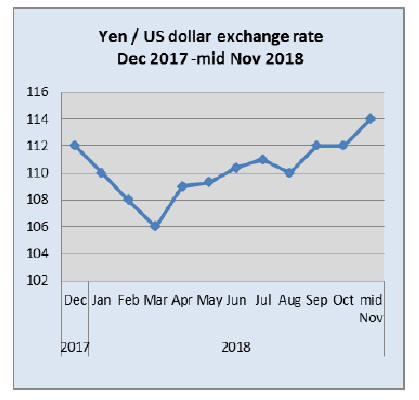
Revival of housing ¡®eco-points¡¯ ahead of
consumption
tax hike
The Ministry of Land, Infrastructure, Transport and
Tourism is thinking about re-introducing the ¡®eco-point¡¯
subsidy programme to promote building and renovation of
energy-efficient homes. Behind this revival is the aim to
help limit the likely decline in housing starts when the
consumption tax is raised from the current 8% to 10% in
October next year.
Under the programme home owners would receive ¡®ecopoints¡¯
when homes meet energy-saving standards through
improved insulation. The ¡®eco-points will be
exchangeable for environmentally friendly goods and gift
tickets. In 2015, when such a programme was introduced
¡®eco-points¡¯ worth yen300,000 for a new home and up to
yen 450,000 were offered for renovation work to improve
both heat insulation and earthquake resistance.
The government is also considering expanding the existing
tax relief for home loans and a cash handout for low and
middle-income home buyers.
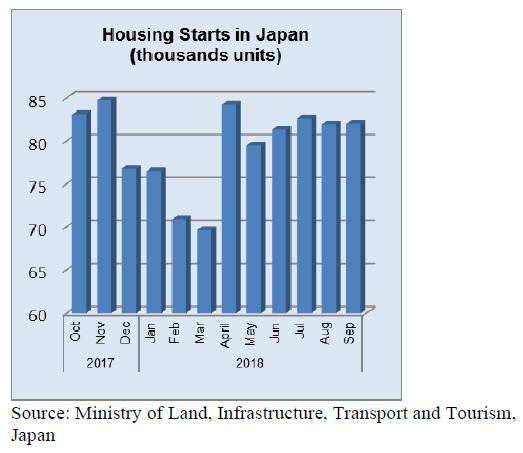
Furniture imports
In line with trends observed in previous years, the third
quarter of the year traditionally marks a turning point for
Japan¡¯s imports of wooden furniture.
In every year since data has been provided in this report
wooden furniture imports to Japan dip in the first two
quarters of the year and reverse direction in the middle of
the second quarter and an upward trend is generally
recorded into the final quarter of the year. However, while
this overall trend applies to wooden office and bedroom
furniture it is less pronounced with imports of wooden
kitchen furniture.
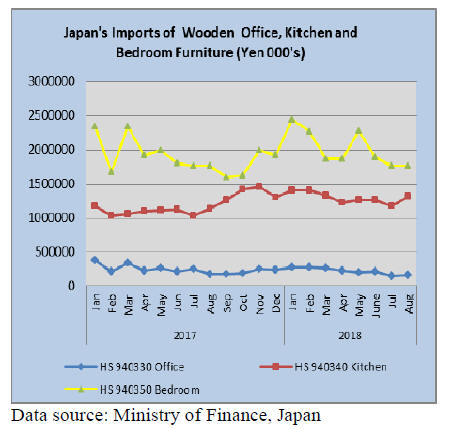
Office furniture imports (HS 940330)
The top three shippers of wooden office furniture
(HS940330) to Japan in August were China which
accounted for 45% of all wooden furniture imports
followed by Italy 11% and the US 10%. Other significant
suppliers of wooden office furniture in August were
Poland and Portugal.
August marked the first time manufacturers in the US had
shipped such a high value of wooden furniture to Japan.
August 2018 shipments from the US are at a record around
being some ten times the value shipped in July.
Year on year, Japan¡¯s wooden office furniture imports in
August were down 6% but in contrast month on month
imports were up around 7%. Compared to the value of
wooden office furniture imports in the first eight months
of last year 2018 imports over the same period were down
14%.

Kitchen furniture imports (HS 940340)
The value of Japan¡¯s wooden kitchen furniture imports
(HS940340) continue to move in a very narrow range.
Tracking exports of this category of furniture over the past
4 years it has been observed that wooden kitchen furniture
imports do not follow the month by month trend observed
for both wooden office and bedroom furniture signaling
there are different demand drives in play for wooden
kitchen furniture.
Year on year, August imports of wooden kitchen furniture
were up 17% and month on month import values rose
12%. The top three shippers of wooden kitchen furniture
to Japan in August were the Philippines at 47% of all HS
940340 imports followed by Vietnam at 35% and China at
9%. In August shipments from Vietnam rose 11% month
on month and Chinese shippers secured a 50% rise in
month on month exports to Japan.

Bedroom furniture imports (HS 940350)
It appears that the value of Japan¡¯s imports of wooden
bedroom furniture (HS940350) bottomed out in July
which fits with the pattern of imports in previous years.
Both year on year and month on month there was virtually
no change in the value of bedroom furniture imports.
China and Vietnam dominate Japan¡¯s imports of HS
940350 with China accounting for 56% of August imports
and Vietnam a further 31%. However in August both the
top suppliers lost market share to other suppliers. Thailand
increased shipments in August and two new comers,
Lithuania and Poland, made it to the list of top 20 shippers
in August.

Trade news from the Japan Lumber Reports
(JLR)
The Japan Lumber Reports (JLR), a subscription trade
journal published every two weeks in English, is
generously allowing the ITTO Tropical Timber Market
Report to reproduce news on the Japanese market
precisely as it appears in the JLR.
For the JLR report please see:
http://www.n-mokuzai.com/modules/general/index.php?id=7
Promotion to hire foreign workers
The government has started to promote hiring foreign
workers as one of solutions to cover labor shortage by
depopulation of Japan and aging labor force. It will form a
new law for status of residence for foreigners.
Presently there is technical intern system to accept foreign
workers. This is to hire and train foreign workers for five
years and as of 2017, there are about 270,000 foreign
trainees working in Japan. However, there are three
categories for the qualification. System one allows one
year to stay. System two allows three years and system
three allows five years, depending on type of job.
System one is applied to any type of job and system two is
applied to 77 jobs, which does not include jobs like
lumber, plywood, laminated lumber and precutting so
trainees for these business are allowed only one year¡¯s
stay.
Now the National Federation of Log and Lumber Co-op
Association is trying to have system two for wood related
jobs so that workers can stay three years. Wood industry
needs imported workers and training period should be
longer than one year since they need to learn high skills.
System two requires official examination of technical
skills and the test is equivalent to basic degree of National
Trade Skill Test System .
System two does not include lumber manufacturing and
processing but includes manufacturing fixtures,
maintenance of machines, industrial packaging and
carpentry for construction and about 2,500 foreign
workers are engaged in these jobs now.
The government is aware of the needs so it will set new
staying qualification and establish entry and staying
administration bureau in 2019. New qualification for five
years stay requires certain ability to communicate in
Japanese language and completion of technical training.
Wood demand projection meeting
The Forestry Agency held the second demand projection
meeting recently. Projection for the fourth quarter this year
and the first quarter next year is increase of domestic
wood and decline of imports.
Time limit to withhold 8% consumption tax is contracts
made by April 1, 2019 even with delivery is after October
2019 when the tax rate is increased to 10% so rush-in
demand should arise during the first quarter next year but
negative factor is decline of both supply and demand as a
result of recent successive natural disasters such as
earthquakes, typhoons and unusual heavy rains.
Also trade friction between U.S.A and China, which may
result in decline of crating lumber demand.
Housing starts forecast for 2018 by 13 private think tanks
is 951,000 units. However, forecast by top managements is
down by 4,000 units from previous forecast with the
comment that there is no sign of demand pick-up before
the tax rate is increased.
Demand for domestic logs will increase for plywood with
start-up of new mills. Log demand for lumber for the
fourth quarter this year is down from the same quarter last
year because of successive natural disasters then there is
some expectation of demand pickup in the first quarter
next year.
North American log import for the second half of this year
would decrease compared to the first half while North
American lumber would increase in the second half.
Import of European lumber continues to increase after
October. Solid wood European lumber demand would
increase while lamina for beam manufacturing would
decrease. Total supply of structural laminated lumber
including laminated beam would increase with more
supply capacity in Europe.
Expectation for last minutes rush-in demand before tax
increase is strong. Domestic manufactured laminated
lumber supply would decrease in the first quarter next year
compared to the same quarter this year.
Supply of imported plywood from Malaysia and China
would decrease while Indonesia and Vietnam would
increase slightly.
Radiata pine demand continues shifting from New Zealand
logs to Chilean lumber. Russian supply of logs would
continue declining and shifting to lumber and veneer
would continue.
Change of wood based house members
By the survey made by the Japan Forest Products Journal
on ranking of wood based house builders, questionnaires
were sent out to 400 builders to find out what type of
materials they use as members of house building.
For post, 82.2% use laminated lumber, the highest since
the survey started in 1998. It was 60.8% in 1998. In this,
percentage of domestic laminated lumber was 23.6%.
25.0% of redwood, 2.5 points up from 2017 and 21.6% of
whitewood, 1.0 points up. Domestic cedar laminated post
was 17.3%,1.1 points less and cypress laminated lumber was 6.3%.
Solid wood post of cedar was 9.2%, 0.4 points less and
cypress was 6.2%, 10.4 points less.
For beam, 69.4% was structural laminated lumber, 3.4
points less. In this, redwood was 43.9%, 2.2 points up and
KD Douglas fir solid wood was 22.1%, 4.8 points less.
Cypress is the top for sill with 33.4%, 7.9 points less.
Laminated lumber for sill was 29.4%, 2.8 points less.
Others are hemlock, Douglas fir and yellow cedar.
South Sea (tropical) log market
After log export ban in Sabah, Malaysia, log supply for
Japan was expected to drop considerably but the importers
have developed sources in PNG and necessary volume is
secured and plywood mills keep running.
Species from PNG is mersawa, which prices are 20-30%
higher than meranti regular in Malaysia. This is tough deal
for plywood mills but no choice.
Supply of keruing and melapi logs for lumber
manufacturing is also exhausting and lumber supply is
also unstable.
Lumber demand has not recovered even in fall. Orders for
laminated free board for construction are not increasing so
distributors¡¯ inventories are not decreasing so they stopped
ordering to supply side.
Indonesian mercusii pine laminated free board prices are
getting weak.
South Sea hardwood plywood
Facing approach of rainy season and declining log supply,
plywood mills in Malaysia and Indonesia are proposing
higher export prices with reduced volume. In the past,
plywood mills in producing regions build up log
inventories before arrival of rainy season but this year is
different.
With tight supply of logs even in summer months, mills
are not able to build up log inventories so now offer
volume is much less than normal volume. Also plywood
mills sell some portion of logs for export to generate profit
even when mills rely on log supply from its own
timberland. Also Sabah, Malaysia banned log export since
last May so ample log supply was expected for plywood
mills but in reality log harvest is stagnant by investigation
of the central government for illegal harvest so the
situation is the same as Sarawak.
Actually plywood mill in Sabah, Sinora Sdn Bhd stopped
plywood manufacturing because of log supply shortage.
Sinora has been supplying about 4,000 cbms of 12 mm
structural and concrete forming plywood a month for
Japan market. Also Korindo, Indonesian plywood mill
shut down some of plywood mills.
Korindo is the only manufacturer of coated concrete
forming panel for Japan and has been supplying about
7,000 cbms a month from two plants. It stopped the
operation of KAS plant so the supply volume will be down
by half. Korindo shut down in late last year and early this
year for about two months because of log shortage.
Log supply is one reason but Korindo accepted too much
orders before log prices soared so more they run, more
loss for the company. After all, weather factor and tighter
restriction of illegal harvest cause tight log supply so even
in dry season, log supply was not enough.
Proposed prices by Malaysian suppliers are about US$690
per cbm C&F on JAS 3x6 coated concrete forming panel
and about US$590 on JAS 3x6 uncoated concrete forming
panel.
Both are up by US$10 from September. Indonesian mills
are following Malaysian prices. The export prices are
expected to keep climbing during rainy season by drop of
log supply.
In Japan, the market for imported plywood continues dull
but as higher cost cargoes keep arriving, the importers are
proposing higher prices while low cost inventories have
been consumed. Market prices of JAS 3x6 coated concrete
forming panels are 1,480 yen per sheet delivered, 30 yen
higher than September but the importers asking prices are
over 1,500 yen.
Since September was the month of mid-term book closing,
there were some low priced offers to dispose of the
inventories so the prices varied much but October is
different. Prices of JAS 3x6 uncoated concrete forming
panesl are about 1,320 yen per sheet and of JAS 3x6
structural panel are 1,340 yen per sheet. Both are up by 20
yen from September. In any case, the market prices have
been edging up on all the items. Higher cost, further
increase is necessary.
The suppliers export prices are US$315-320 on thin board
per cbm C&F and $305-310 on square. Arauco plans to
increase the supply volume of both green and KD lumber
so number 8 ship¡¯ volume will be 20,000 cbms.
Demand by other market is changing. By trade war with
the U.S.A., KD lumber for furniture to China is declining
then crating lumber for Korea is also dropping because of
decreasing demand of export crating lumber for China.
Part of these will be coming to Japan. Demand of KD
lumber by North America and Central America is active
for interior laminated lumber and wood pallet but these do
not compete with demand for Japan.
 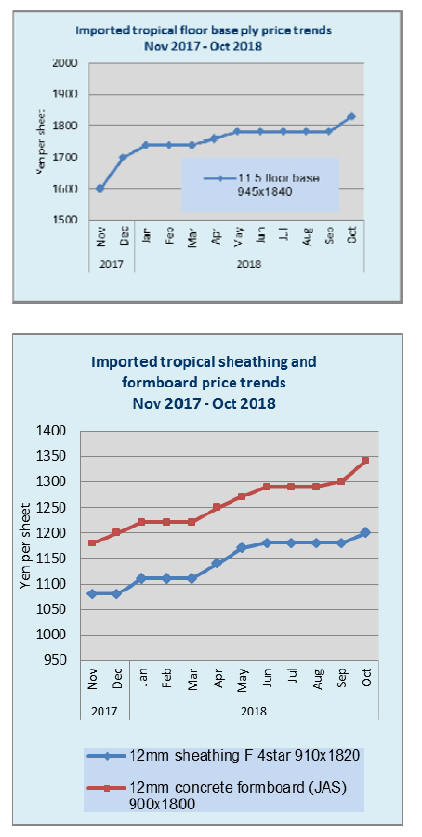
|